Let me set the stage for you. You’re in the stands of the 2016 NCAA women’s volleyball tournament, the quarterfinal match between the No. 3-seeded Wisconsin Badgers and the No. 6-seeded Stanford Cardinal.
“The game against Wisconsin in the quarterfinals — that’s a game that will always stick out to me.”
The game is in Madison, Wisconsin, and the stands are full of Badger fans rabid for their team, which only lost four games all season, to advance to the Final Four in Columbus, Ohio. What’s more, Wisconsin is up 2-0, dominating the first two sets.
“We were in an environment that was completely against us. We had 10 total Stanford fans, and everyone else was like, ‘Wisconsin!’”
What’s more, the Stanford volleyball team is starting four true freshman in its rotation — its starting libero, outside, setter and one of its middle blockers are all brand new to college volleyball. The road to the Final Four is just a matter of waiting for the inevitable.
“How we rallied back will always kind of stick in my mind.”
One week after one of the most intense games of her life, then-freshman middle blocker Audriana Fitzmorris, ’20, is cutting down the net in Columbus, celebrating with her team by her side.
The Stanford women’s volleyball recruiting class of 2016 may go down as one of the greatest collective groups in the history of the sport. In just one year, the Cardinal recruited just about an entire court full of All-Americans. They collected Morgan Hentz ’20, a libero out of Lakeside Park, Kentucky, the 2017 Pac-12 Libero of the Year and possibly the best defensive specialist in college volleyball. They added Jenna Gray ’20, a setter from Kansas City, the 2017 Pac-12 Setter of the Year and one of only a few freshman setters to ever lead a team to a national championship. And, the Cardinal recruited the crown jewel of the 2016 class, Kathryn Plummer ’20, a 6’6” outside hitter from Aliso Viejo, California, whose list of accolades seems almost too lengthy. Plummer was the 2016 Pac-12 Freshman of the Year, the 2017 ESPNw Player of the Year and the 2017 AVCA player of the year. On top of that, she is a two-time first team All-American — not to mention the most terrifying outside hitter in college volleyball.
Big players, big talents, big personalities. But if you look past these larger-than-life volleyball legends in the making, you’ll find the fourth member of this miraculous group of classmates.
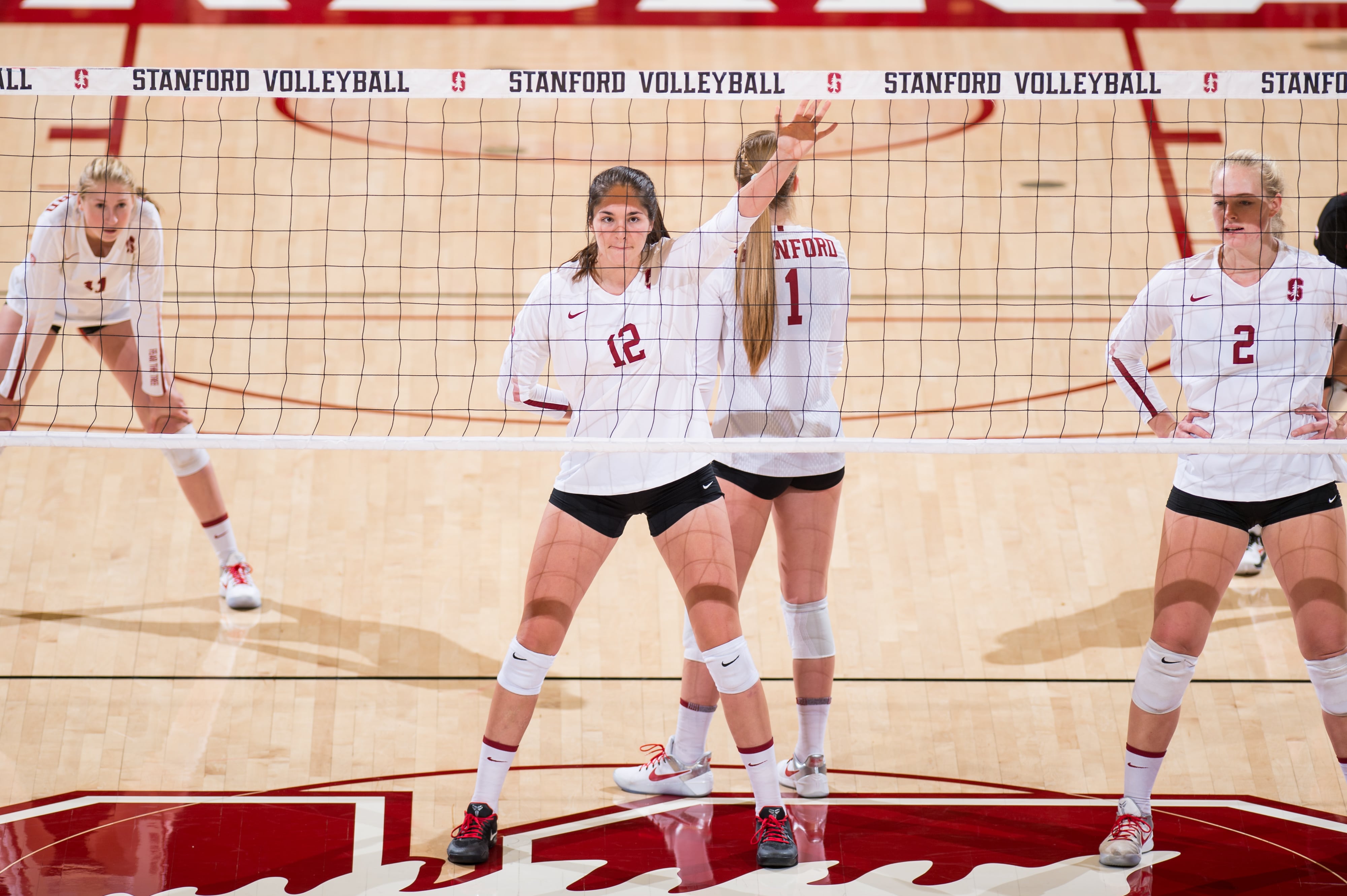
The gentle giant
Audriana Fitzmorris is, in the truest sense of the phrase, a gentle giant. At 6’6” she is the tallest member of the tallest volleyball squad in the country, standing maybe a hair and a half over Kathryn Plummer. When I asked her who was actually taller, she laughed and proclaimed the question “controversial” before finally relenting and claiming she had the edge.
And that’s Fitzmorris, captured in a single moment. A more reserved, quiet personality than some of her eccentric teammates — teammates who do nothing but admire and appreciate her caring, inquisitive, selfless nature.
In the words of the team’s head coach, Kevin Hambly, “There’s nothing about her that is not positive. She is always striving to be the best athlete, the best human being, the best student. She’s really curious about life — she is exploring this world, consuming as much of this world as she can. And she does it in this very quiet, soft-spoken kind of way, but she is attacking life in every possible way, and I love it.”
And yet, her soft, laughter-filled voice and her omnipresent smile aren’t exactly representative of her presence on the court. Calling her “gentle” betrays the enormous shadow she casts over opposing volleyball players as she stuffs their attacks into the ground.
The best feeling in volleyball, according to her? “Great stuff block. That feeling of clap boom. Big block over big kill.”
Make no mistake, Fitzmorris is one of the most fearsome competitors and talented volleyball players on this team of absurd athletes. Aside from Kathryn Plummer, she’s the only member of the recruiting class to be named an All-American in both of her years on the team.
Fitzmorris has been playing volleyball since she was in middle school, and in this sport, when you’re young and you’re tall, you get placed squarely in the middle of the court, at the middle blocker position. Coming into high school, she measured officially at 6’3”.
Fitzmorris’ parents are the 6’7” Michael Fitzmorris and 6’2” Maria Luisa Fitzmorris. They both played professional basketball in Peru. Her older sister is 6’5” Alex Fitzmorris, who played volleyball at Morehead State, Boston College and Arkansas, and was a major inspiration for Audriana Fitzmorris to pick up the sport. And her younger brother is 7’0” Keenan Fitzmorris ’22, a current freshman at Stanford who plays center for the basketball team. Their five heights are the approximate measurements of a starting lineup in the NBA.
She attended high school at St. James Academy in Kansas City. Sound familiar? That’s right, she actually went to the same high school as setter Jenna Gray. The two have been playing volleyball together now for seven full years.
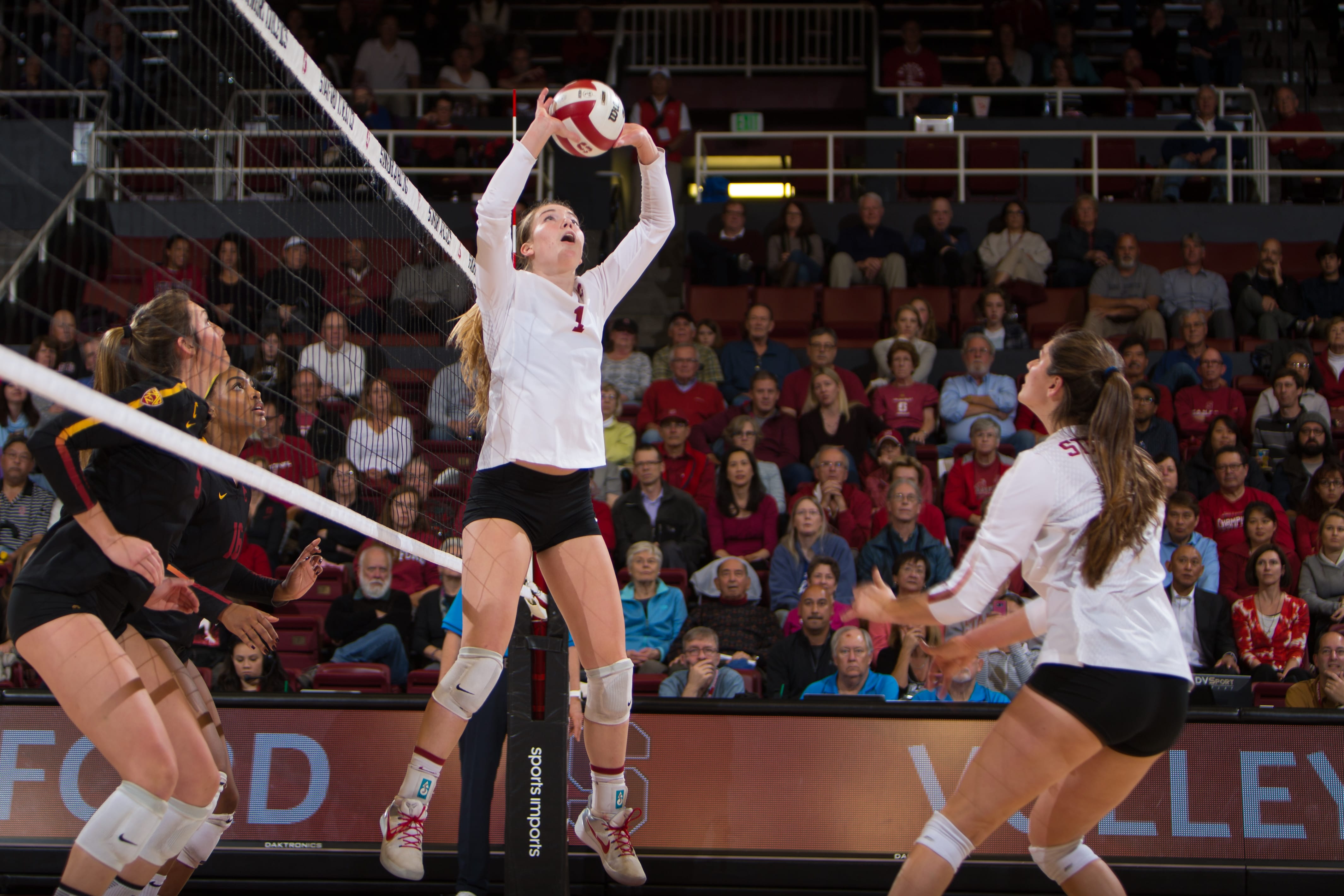
Jenna thinks it’s given the duo a special connection on the court. “I definitely think that playing alongside each other for such a long time has given us an intuitive connection. We have gotten a really good understanding of how to read and communicate with each other.”
And yet, they independently decided to attend Stanford, after an arduous recruiting process that began in eighth grade and ended with verbal commitments to the Farm.
Moving onto the team
Fitzmorris arrived on campus with one goal in mind: to get on the court and start playing as soon as possible. Middle blockers usually come in pairs within a volleyball rotation, so she was fighting for one of two spots. On top of that, one of the best middle blockers to ever come through Stanford was returning as a redshirt senior after missing the previous season with a knee injury: four-time All-American and fifth-year senior Inky Ajanaku, ‘17.
“Inky Ajanaku was one that … I would always watch [as a middle blocker,]” Fitzmorris told me. “Being able to play on the same side of the court as her is incredible — you don’t want to play on the opposite side of her, but playing on the same side of the court as her … I learned so much my freshman year from blocking against her, from her leadership. It was cool to see her progression through the season just coming back from the injury and how much better she got, how much more comfortable she got.”
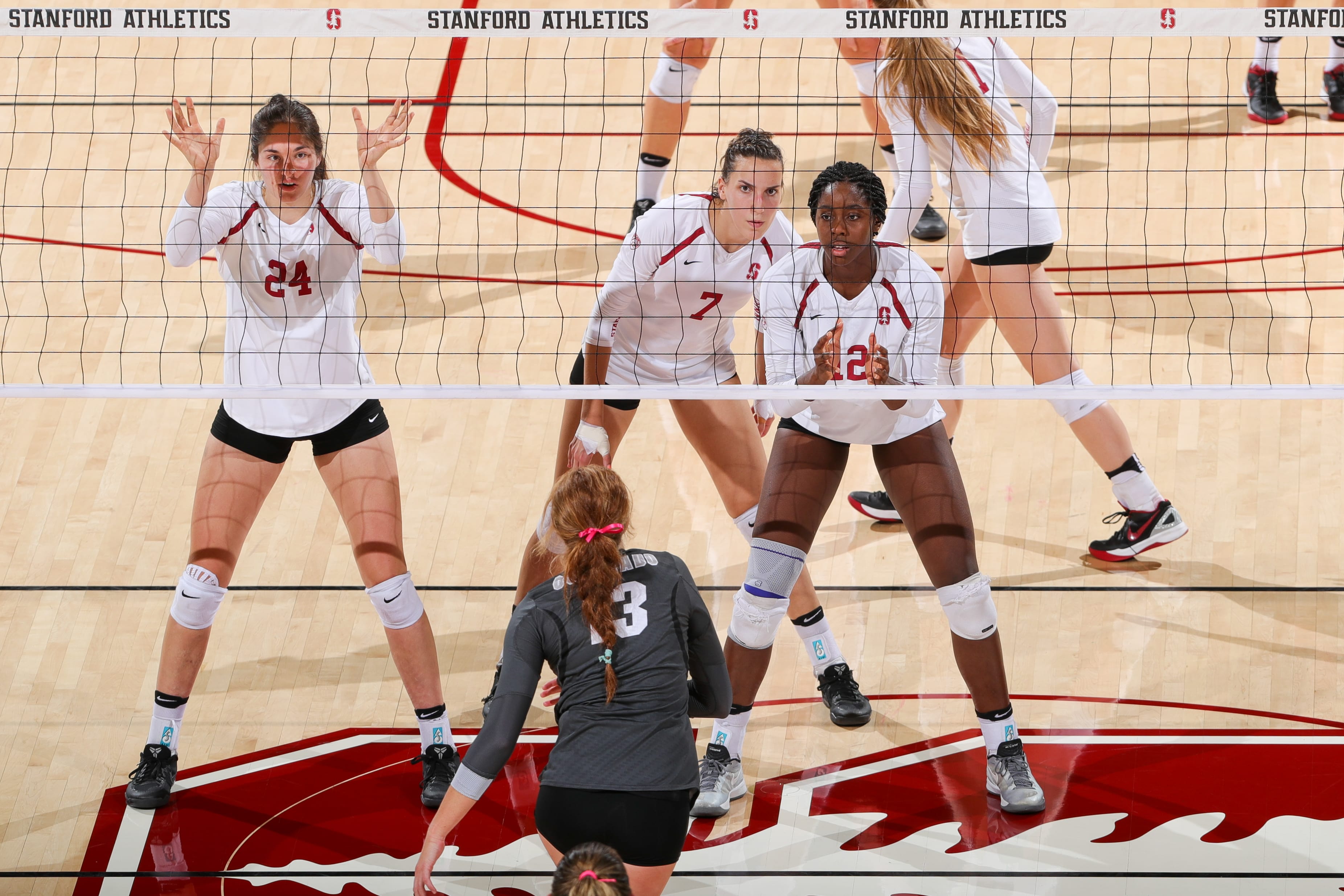
Even to snatch the second spot, Fitzmorris had to overcome issues of depth. With the type of mindset that she has towards the game, this was a blessing in disguise.
“I got there and was like ‘Okay, let’s work,’” Fitzmorris said. “I definitely felt like I had to earn every minute that I got on the court. I’ve always felt that way — high school, club, whatever. I’ve always wanted it to be that way.”
It worked. She started in the first game of the season.
2016: The storybook season
The 2016 Stanford volleyball season was something straight out of a movie. Four upstart, inexperienced, talented freshmen, a legendary veteran returning from a crippling injury and the greatest women’s volleyball coach of all time, John Dunning, back for one final year before retirement.
“John Dunning is a name I think everyone in the entire volleyball world knows,” Fitzmorris said with a smile on her face.
They finished the regular season 27-7. They still placed second in the Pac-12 behind Washington but entered the tournament as the sixth overall seed.
In one of the most intensely dramatic moments of the movie, the team was down 0-2 to Wisconsin, as I alluded to earlier. Rallying back in a hostile crowd, they played near perfect volleyball as they booked their ticket to the Final Four. Fitzmorris knocked down 10 kills on .333 hitting with seven digs. More importantly, she and Ajanaku led the Cardinal defensive front, with Fitzmorris accounting for a massive three solo blocks and assisting on three more.
They were the team of destiny at that point, upsetting No. 2 Minnesota 3-1 in the semifinals before moving on to the championship against the No. 4 Texas Longhorns. In an all-time classic game, Stanford claimed the national championship 3-1, with Fitzmorris putting up 10 kills, four digs and three blocks on a .375 hitting percentage.
Fitzmorris was on the court for the final point, a Plummer spike into the Texas block, which spiraled out of bounds in Longhorn territory. The tension amongst the team broke into excitement, tears and a massive hug in the center of the court.
“I would just say it was surreal,” Fitz said about the team’s upset victory. “It was almost like I was removed from the situation for a little moment, being able to see all of it in sort of like the third person. We had worked really hard that season. It was very bumpy, up and down — didn’t know what to expect most of the time. That moment with my teammates was amazing.”
Stanford claimed its seventh women’s volleyball title that year, tying Penn State for the most all-time championships in the sport. The Cardinal sent John Dunning into retirement and Ajanaku into the pros with one final win under their belts.
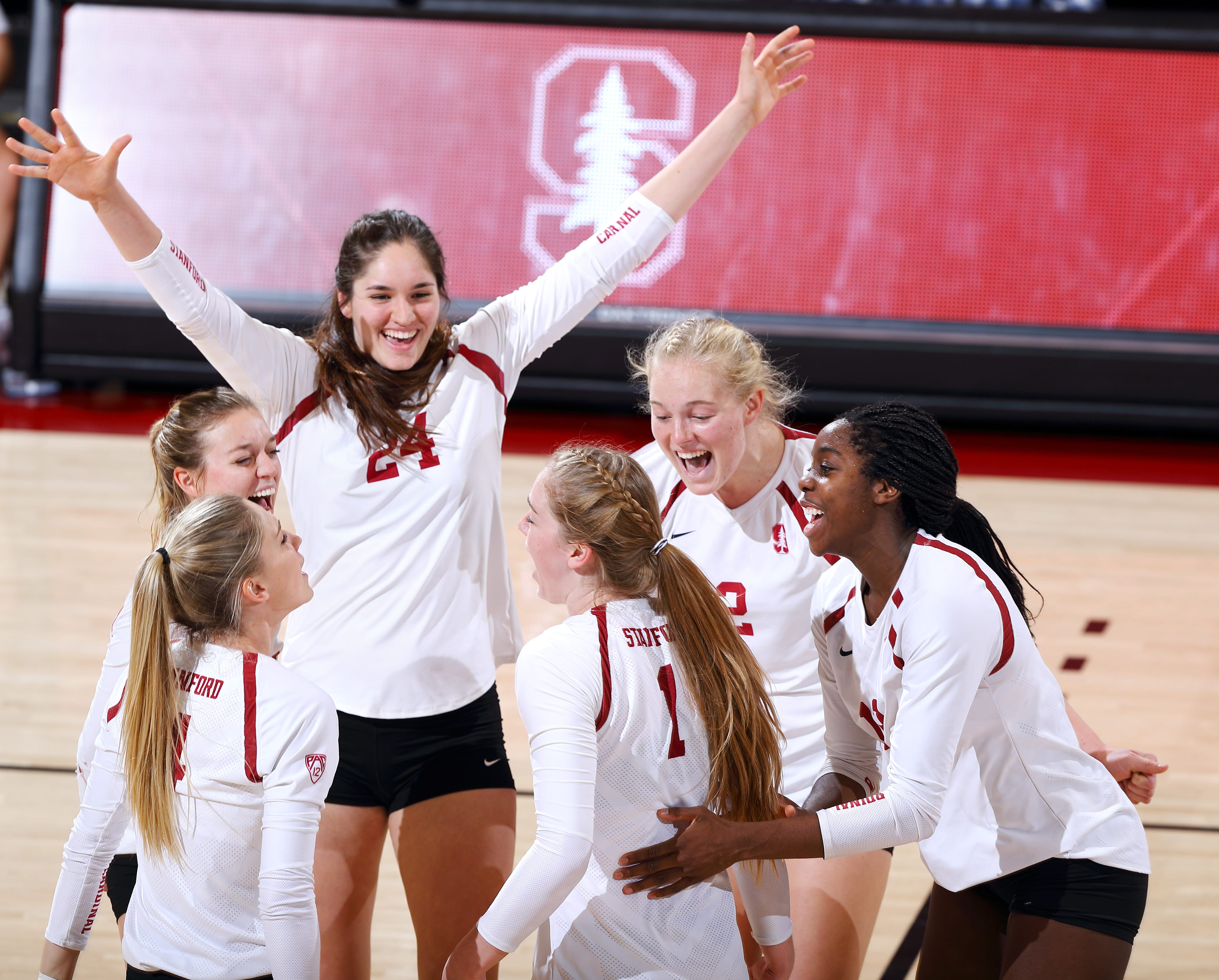
2017: Utter dominance
The 2017 team wasn’t out of a movie. It was an absolute killing machine. Enter former Illinois coach Kevin Hambly.
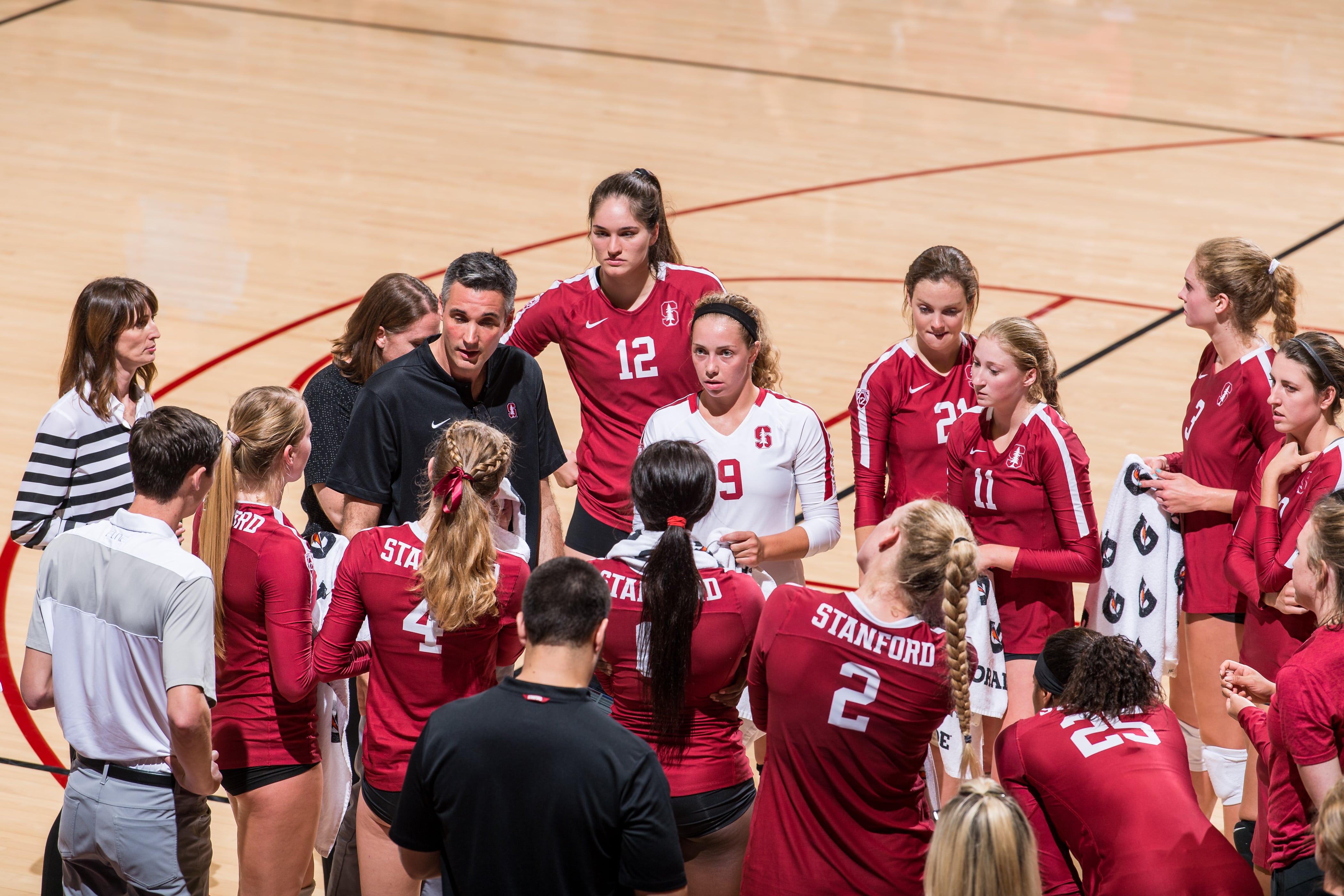
Strangely enough, Hambly and Fitzmorris already had a personal relationship as he had been recruiting her to play for Illinois back in high school. “I’ve known their whole family long, long before I was here,” the head coach told me.
Whatever amount of adjustment was required, it happened quickly. After losing two times to Penn State within the first two weeks of the season, the Cardinal went on an absolute tear. They won 16 straight games in the middle of the season and only lost once more, to Washington on the road. Final Record: 30-3, 19-1 in the Pac-12.
Fitzmorris did not slow down her learning or her growth.
“I knew more of what to expect. Going through the whole freshman season, everything is kind of new — you’re just like, ‘Oh, we do this now? This is how this works?’” she said. “But sophomore season, you know what to expect so you’re more comfortable in the logistics of things. I was more able to focus on the technique and put myself in situations where I was more useful and more efficient.”
Stanford rolled its way to its first Pac-12 title since 2014 and entered the tournament as the third overall seed. In a bracket that led them through a quarterfinals showdown with the Texas Longhorns, the Cardinal put on an absolute clinic, only dropping one set through four games.
Principle in these wins was Fitzmorris, whose ability to attack off of a slide was absolutely crushing opposing defenses, letting her hit incredibly efficiently. She averaged a hitting percentage of over .400 in the bracket stage, including a 10-0-12 night for a .833 performance against CSU Bakersfield.
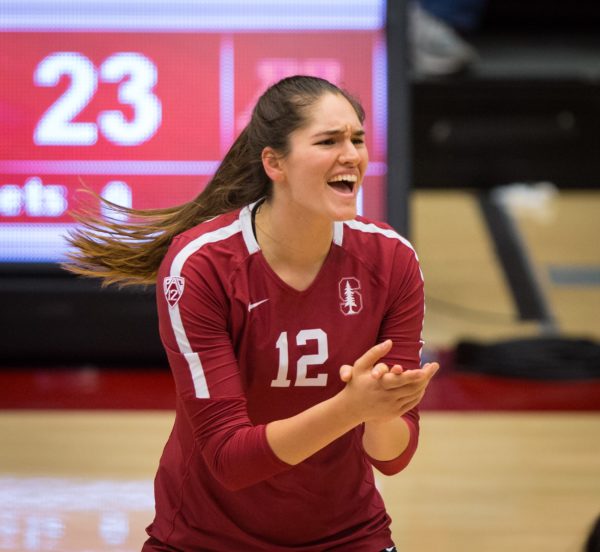
The team advanced to the Final Four, which was held in Kansas City. Gray and Fitzmorris found the opportunity to compete in their hometown, with high school friends, family, coaches and countless others cheering them on.
They faced off against the No. 2 Florida Gators in the semi-finals. And suddenly, after a season of dominance, the team looked mortal.
“I’m a firm believer that anyone can beat anyone else on any given day, but the most disappointing thing was coming from that game knowing that we hadn’t played our best, hadn’t gotten to the level that we knew we could,” Fitzmorris said.
The Cardinal fell behind to an early 0-2, a position they’d been in before. But despite rallying back, tying the score and forcing a 15-point fifth set, they couldn’t close out the job.
“Since we didn’t get to that point as a team, it was disappointing to walk away from and know we could have done better.”
Despite looking so dominant in the bracket, Fitzmorris nearly vanished during the semifinal game. Her slide hit was not landing, and she was incredibly ineffective, posting one of the worst performances of her college career. She hit 27 balls, eight for kills and six for errors: a .074 hitting percentage. She only accounted for four blocks through five sets, no digs and one service error.
“I’m not one to make excuses, but I’ve been dealing with a back injury for the last season now, which sucks, but it is something I have to battle day in and day out,” Audriana said. “There’s a lot of variability with it… I think towards the end of the season my body kind of took a hit but still tried to work through it for the last few games. [In] the semifinal, unfortunately, I wasn’t able to go past my injury as I’m usually able to do.”
The Cardinal entered the offseason with unfinished business.
New year, new position
And suddenly, there was a massive change. Coach Hambly made the decision to remove Fitzmorris from the middle blocker position.
“[She] and I had kind of talked about it,” Hambly said. “It wasn’t this big eventful thing — I think she always kind of wanted to try out the different positions. She’s very curious and studious and loves learning — that’s one of the main things that motivates her.”
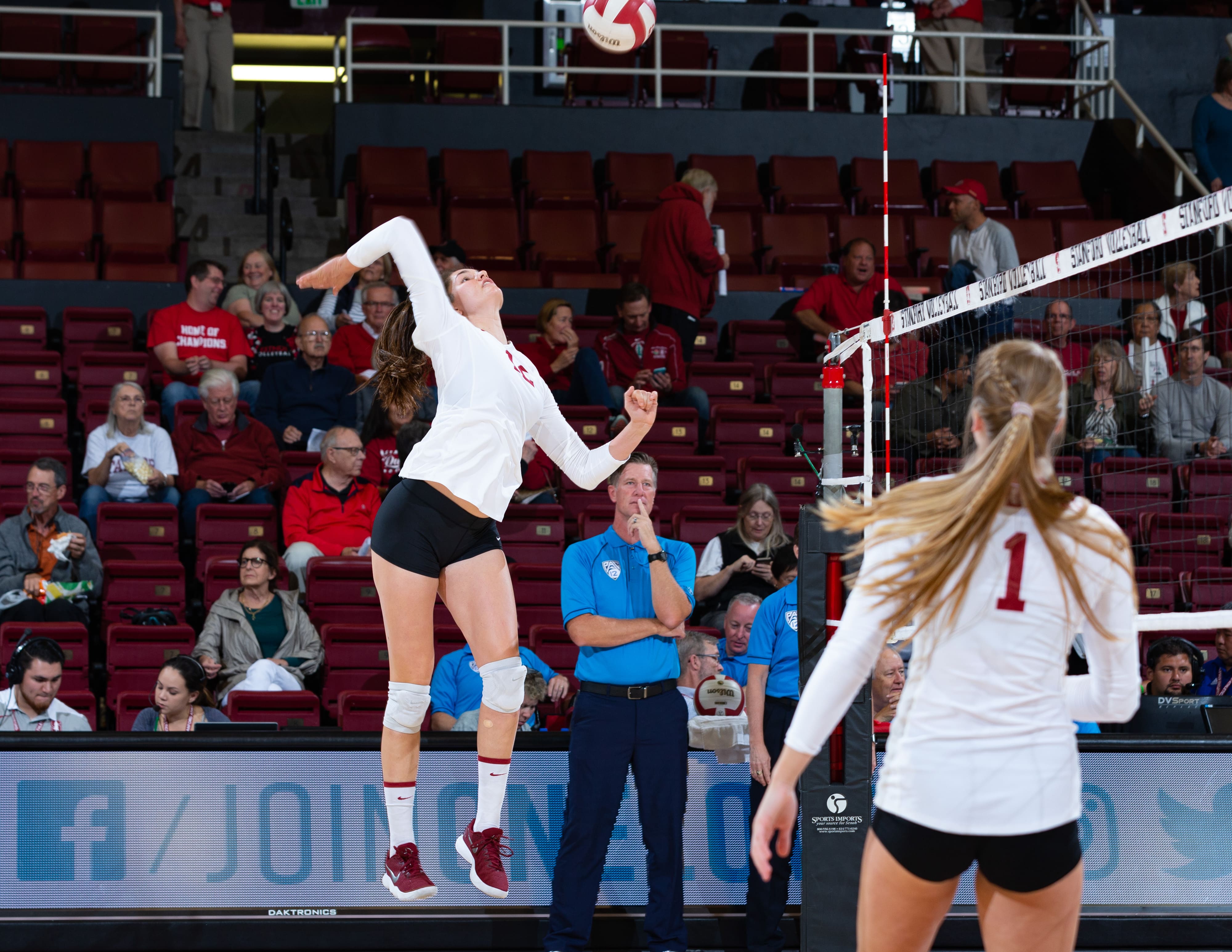
Still, taking your two-time, All-American middle blocker and uprooting her from the spot she’s been in since middle school seems like a big step. Hambly doesn’t see it that way.
“I always thought she’d be better as a pin, either a left or a right, just from her physiological makeup,” he said. “Se’s not a super twitchy kid, but she’s long and smooth and it makes her a better outside or right side.”
Hambly told me that when the recruiting process first began all those years ago in high school, he initially saw her as a pin player — that is, playing on the left or right side of the net. In fact, the initial plan was for her to play the entirety of the 2017 season as an opposite hitter.
“I was kind of hoping we could get one of the two middles to develop, and it just didn’t take. It made more sense to have her in the middle,” Kevin said. “I was disappointed — she did a great job [and] put up great numbers, but the minute we got out of the season I knew we wanted to put her on a pin.”
With Plummer and McClure holding down the outside hitter position coming into 2018, it made more sense to put Fitzmorris on the right side, at the opposite position. This was especially true given the graduation of opposite Merete Lutz, ’18.
“Merete had an incredible impact on the team. She was an incredible person and I loved her — on the court she contributed so much and was a termination player in times that we needed her,” Audriana said, paying respects to her former teammate.
But this swap at the position wasn’t a downgrade from the experienced veteran at all in Hambly’s eyes. If anything, it was an upgrade.
“Merete was 6’8”, and that doesn’t seem like that big of a difference — the 6’6” to 6’8”,” he explained. “Merete was this big powerful thing that could only go in straight lines — she wasn’t nimble. Audriana moves on the floor a lot better; she can play defense better; she can pass. Audriana is a better all-around volleyball player than Merete.”
The opposite is an incredibly interesting position in the sport of volleyball. Because of their primary attacking position on the right side the court, they’re the player most often responsible for blocking the other team’s best opposite hitter. They’ve also got to be a reliable, terminating option, as they attack a weaker block than the outsides tend to.
Kathryn Plummer maintains that having Fitzmorris on the right opens up the entire offense. “She gives so many people one-on-one opportunities because other teams are keying on her a lot in the three hitter rotations,” Plummer said. “Having Audriana on the right side spreads out our offense and allows us to have a lot more options. She’s so versatile at every position in the front row and can hit every set, so our offense becomes a lot more fun.”
Fitzmorris’ shot has a great deal of finesse and control to it, something she displayed in spades with slide hits from the middle position. She’s also one of the team’s best blockers and brings that experience with her from the middle.
As she put it: “I’m pretty analytical — I like seeing little technique stuff, so it’s beneficial to have that middle experience, to know as a middle what I was expecting from the right side and, as a right side now, [to] know what I’m expecting from the middles.”
However, the opposite is tasked with playing in the back row of the rotation as well, involved in receiving and passing, something middle blockers tend not to do. Fitzmorris’ diverse physical skillset should allow her to bring a massive improvement to this aspect of the Cardinal offense.
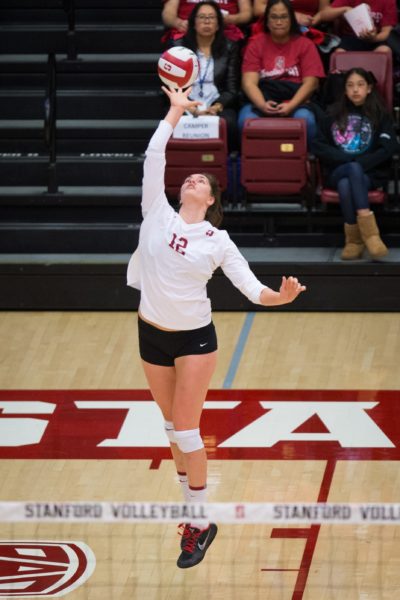
The decision to move Fitzmorris may also have had something to do with the arrival of freshman middle blocker Holly Campbell ’22, who has stepped up in a huge way for the Cardinal so far this season. She’s performed admirably in the role that Fitzmorris played until this season, acting almost as a plug and play, letting the Cardinal continue their dominance from last season.
There’s also a hope from the team that playing the opposite position will prevent any further complications with Fitzmorris’ back injury.
“The middle [involves] a lot of jumping, slides that are putting asymmetrical distribution on your body, so that also probably contributed to my back. It’s a healthier position [to be] on the right side,” Fitzmorris said.
Fitzmorris has started every game this year at the opposite position and has been improving steadily in every game. So far this season she’s averaging 3.00 kills per set, way up from her previous marks of 2.41 and 2.31. She’s also hitting .364 on the season.
The most important part of her transition to the right side to consider, however, is her personal enjoyment. She’s been playing in the middle for so long, that when I asked her if she enjoyed playing the position, she gave a sigh and a laugh, and she didn’t know immediately what to say.
“I think I’m gonna get there. I think I still love playing, especially with my teammates,” Fitzmorris said. “I think I’ll get to the point where I love the position, but there’s a lot of pressure I’m putting on myself and a lot of learning to do. When I hit a point of comfort and adaptation, I think I will like the position.”
The Fitzmorris way
Fitzmorris has all the support in the world from the team, from her coaches, from her family, friends, peers and every single Stanford volleyball fan in the world, including me. Fitzmorris is universally beloved. She’s inquisitive, supportive, selfless, joyful, curious, generous, kind, hard-working, and that’s just a list of adjectives taken directly from the few people I asked about her.
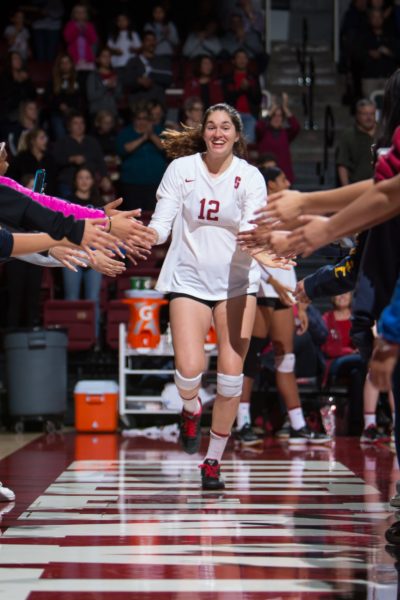
She’s a human biology major, and her personality shows itself even in her studies and career path. “I’ve always been interested in health and medicine from a young age,” she said. “Through that, I’ve been trying to figure out what I want to do. I always wanted to help people, and I love person-to-person interactions. I’ve always seen medicine as a direct route to being able to help another person.”
But before that, she’d really love to keep playing volleyball as long as possible.
“I love the sport. As long as I’m healthy, I’d love to continue playing and seeing where it can take me,” she said. “I love traveling, [and] I love experiencing different cultures, and volleyball has been able to provide me with a lot of awesome opportunities to do that.”
If you ask any of her teammates or coaches, every single one of them would tell you that Fitzmorris will play professionally one day. Any volleyball organization in the world would be incredibly lucky to have a player as motivated and dedicated to learning the game and improving as Audriana Fitzmorris.
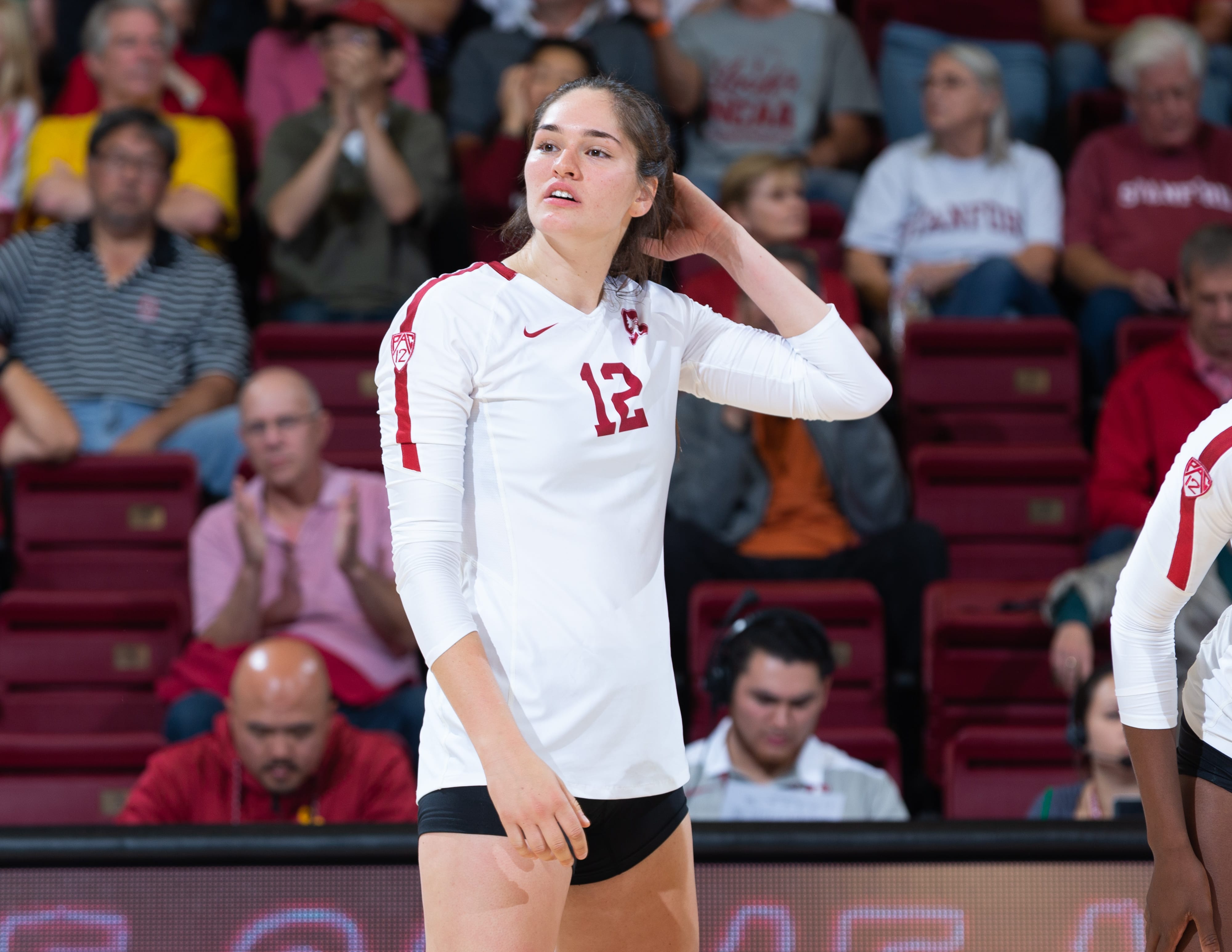
Plus, who knows what her ceiling actually is? Maybe by this time next year Coach Hambly will have her playing libero.
Contact Bobby Pragada at bpragada ‘at’ stanford.edu.